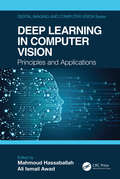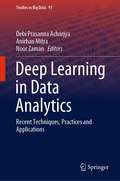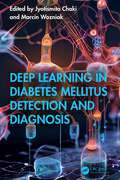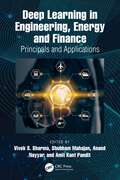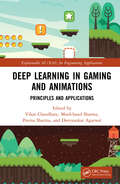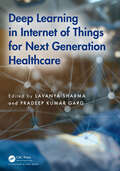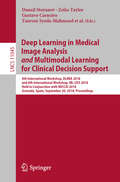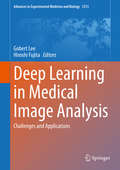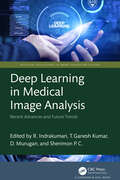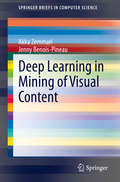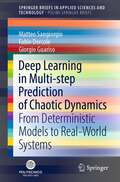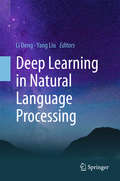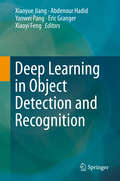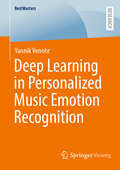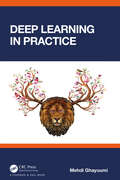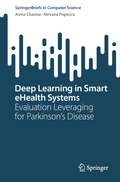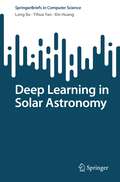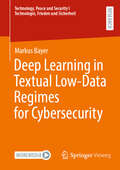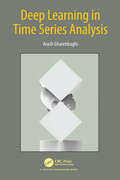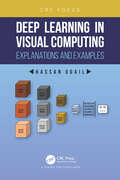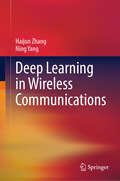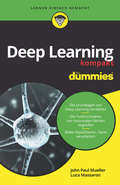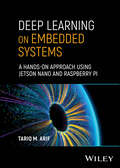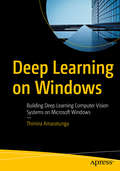- Table View
- List View
Deep Learning in Computer Vision: Principles and Applications (Digital Imaging and Computer Vision)
by Ali Ismail Awad Mahmoud HassaballahDeep learning algorithms have brought a revolution to the computer vision community by introducing non-traditional and efficient solutions to several image-related problems that had long remained unsolved or partially addressed. This book presents a collection of eleven chapters where each individual chapter explains the deep learning principles of a specific topic, introduces reviews of up-to-date techniques, and presents research findings to the computer vision community. The book covers a broad scope of topics in deep learning concepts and applications such as accelerating the convolutional neural network inference on field-programmable gate arrays, fire detection in surveillance applications, face recognition, action and activity recognition, semantic segmentation for autonomous driving, aerial imagery registration, robot vision, tumor detection, and skin lesion segmentation as well as skin melanoma classification. The content of this book has been organized such that each chapter can be read independently from the others. The book is a valuable companion for researchers, for postgraduate and possibly senior undergraduate students who are taking an advanced course in related topics, and for those who are interested in deep learning with applications in computer vision, image processing, and pattern recognition.
Deep Learning in Data Analytics: Recent Techniques, Practices and Applications (Studies in Big Data #91)
by Noor Zaman Debi Prasanna Acharjya Anirban MitraThis book comprises theoretical foundations to deep learning, machine learning and computing system, deep learning algorithms, and various deep learning applications. The book discusses significant issues relating to deep learning in data analytics. Further in-depth reading can be done from the detailed bibliography presented at the end of each chapter. Besides, this book's material includes concepts, algorithms, figures, graphs, and tables in guiding researchers through deep learning in data science and its applications for society.Deep learning approaches prevent loss of information and hence enhance the performance of data analysis and learning techniques. It brings up many research issues in the industry and research community to capture and access data effectively. The book provides the conceptual basis of deep learning required to achieve in-depth knowledge in computer and data science. It has been done to make the book more flexible and to stimulate further interest in topics. All these help researchers motivate towards learning and implementing the concepts in real-life applications.
Deep Learning in Diabetes Mellitus Detection and Diagnosis
by Jyotismita Chaki Marcin WozniakDeep Learning in Diabetes Mellitus Detection and Diagnosis focuses on deep learning-based approaches in the field of diabetes mellitus detection and diagnosis, including preprocessing techniques that are an essential part of this subject. This is the first book of its kind to cover deep learning-based approaches in the specific field of diabetes mellitus. This book includes a detailed introductory overview as well as chapters on current applications, preprocessing of data using deep learning, deep learning techniques, complexity, challenges, and future directions. It will be of great interest to researchers and professionals working on diabetes mellitus as well as general medical applications of machine learning.Features: Highlights how the use of deep neural networks-based applications can address new questions and protocols, as well as improve upon existing challenges in diabetes mellitus detection and diagnosis Assists scholars and students who might like to learn about this area as well as others who may have begun without a formal presentation, with no complex mathematical equations Involves exceptional subject coverage and includes the principles needed to understand deep learning
Deep Learning in Engineering, Energy and Finance: Principals and Applications
by Anand Nayyar Shubham Mahajan Amit Kant Pandit Vivek S. SharmaUnlock the transformative potential of deep learning in your professional and academic endeavors with Deep Learning in Engineering, Energy and Finance: Principals and Applications. This comprehensive guide seamlessly bridges the gap between theoretical concepts and practical implementations, providing you with the knowledge and tools to revolutionize industries and drive innovation. Delve into real-world applications and cutting-edge research that showcase how deep learning is redefining engineering processes, optimizing energy systems, and reshaping financial markets.This book: Explores deep learning applications across engineering, energy, and finance, highlighting diverse use cases and industry-specific challenges. Discovers how deep learning is driving breakthroughs in predictive maintenance, energy optimization, algorithmic trading, and risk management. Illustrates all the concepts connected to Deep Learning from head and heart with real-time practical examples and case studies. Stresses on skills needed to tackle future challenges, with a focus on emerging deep learning technologies oriented towards Solar Energy, SOM’s, Stock Market, Speech Technology and Many more. Whether you're a student eager to explore the latest advancements or a seasoned R&D professional seeking to enhance your skill set, this book offers invaluable insights and practical guidance to elevate your expertise.
Deep Learning in Gaming and Animations: Principles and Applications (Explainable AI (XAI) for Engineering Applications)
by Vikas ChaudharyOver the last decade, progress in deep learning has had a profound and transformational effect on many complex problems, including speech recognition, machine translation, natural language understanding, and computer vision. As a result, computers can now achieve human-competitive performance in a wide range of perception and recognition tasks. Many of these systems are now available to the programmer via a range of so-called cognitive services. More recently, deep reinforcement learning has achieved ground-breaking success in several complex challenges. This book makes an enormous contribution to this beautiful, vibrant area of study: an area that is developing rapidly both in breadth and depth. Deep learning can cope with a broader range of tasks (and perform those tasks to increasing levels of excellence). This book lays a good foundation for the core concepts and principles of deep learning in gaming and animation, walking you through the fundamental ideas with expert ease. This book progresses in a step-by-step manner. It reinforces theory with a full-fledged pedagogy designed to enhance students' understanding and offer them a practical insight into its applications. Also, some chapters introduce and cover novel ideas about how artificial intelligence (AI), deep learning, and machine learning have changed the world in gaming and animation. It gives us the idea that AI can also be applied in gaming, and there are limited textbooks in this area. This book comprehensively addresses all the aspects of AI and deep learning in gaming. Also, each chapter follows a similar structure so that students, teachers, and industry experts can orientate themselves within the text. There are few books in the field of gaming using AI. Deep Learning in Gaming and Animations teaches you how to apply the power of deep learning to build complex reasoning tasks. After being exposed to the foundations of machine and deep learning, you will use Python to build a bot and then teach it the game's rules. This book also focuses on how different technologies have revolutionized gaming and animation with various illustrations.
Deep Learning in Healthcare: Paradigms and Applications (Intelligent Systems Reference Library #171)
by Lakhmi C. Jain Yen-Wei ChenThis book provides a comprehensive overview of deep learning (DL) in medical and healthcare applications, including the fundamentals and current advances in medical image analysis, state-of-the-art DL methods for medical image analysis and real-world, deep learning-based clinical computer-aided diagnosis systems. Deep learning (DL) is one of the key techniques of artificial intelligence (AI) and today plays an important role in numerous academic and industrial areas. DL involves using a neural network with many layers (deep structure) between input and output, and its main advantage of is that it can automatically learn data-driven, highly representative and hierarchical features and perform feature extraction and classification on one network. DL can be used to model or simulate an intelligent system or process using annotated training data. Recently, DL has become widely used in medical applications, such as anatomic modelling, tumour detection, disease classification, computer-aided diagnosis and surgical planning. This book is intended for computer science and engineering students and researchers, medical professionals and anyone interested using DL techniques.
Deep Learning in Internet of Things for Next Generation Healthcare
by Lavanya Sharma Pradeep Kumar GargThis book presents the latest developments in deep learning-enabled healthcare tools and technologies and offers practical ideas for using the IoT with deep learning (motion-based object data) to deal with human dynamics and challenges including critical application domains, technologies, medical imaging, drug discovery, insurance fraud detection and solutions to handle relevant challenges. This book covers real-time healthcare applications, novel solutions, current open challenges, and the future of deep learning for next-generation healthcare. It includes detailed analysis of the utilization of the IoT with deep learning and its underlying technologies in critical application areas of emergency departments such as drug discovery, medical imaging, fraud detection, Alzheimer's disease, and genomes. Presents practical approaches of using the IoT with deep learning vision and how it deals with human dynamics Offers novel solution for medical imaging including skin lesion detection, cancer detection, enhancement techniques for MRI images, automated disease prediction, fraud detection, genomes, and many more Includes the latest technological advances in the IoT and deep learning with their implementations in healthcare Combines deep learning and analysis in the unified framework to understand both IoT and deep learning applications Covers the challenging issues related to data collection by sensors, detection and tracking of moving objects and solutions to handle relevant challenges Postgraduate students and researchers in the departments of computer science, working in the areas of the IoT, deep learning, machine learning, image processing, big data, cloud computing, and remote sensing will find this book useful.
Deep Learning in Medical Image Analysis and Multimodal Learning for Clinical Decision Support: 4th International Workshop, Dlmia 2018, And 8th International Workshop, Ml-cds 2018, Held In Conjunction With Miccai 2018, Granada, Spain, September 20, 2018. Proceedings (Lecture Notes in Computer Science #11045)
by Andrew Bradley João Manuel R. S. Tavares Gustavo Carneiro Vasileios Belagiannis Jacinto C. Nascimento Zhi Lu Lena Maier-Hein Tanveer Syeda-Mahmood Mehdi Moradi Hayit Greenspan Anant Madabhushi Danail Stoyanov Zeike Taylor Anne Martel Joao Paulo Papa Sailesh ConjetiThis book constitutes the refereed joint proceedings of the 4th International Workshop on Deep Learning in Medical Image Analysis, DLMIA 2018, and the 8th International Workshop on Multimodal Learning for Clinical Decision Support, ML-CDS 2018, held in conjunction with the 21st International Conference on Medical Imaging and Computer-Assisted Intervention, MICCAI 2018, in Granada, Spain, in September 2018. The 39 full papers presented at DLMIA 2018 and the 4 full papers presented at ML-CDS 2018 were carefully reviewed and selected from 85 submissions to DLMIA and 6 submissions to ML-CDS. The DLMIA papers focus on the design and use of deep learning methods in medical imaging. The ML-CDS papers discuss new techniques of multimodal mining/retrieval and their use in clinical decision support.
Deep Learning in Medical Image Analysis: Challenges and Applications (Advances in Experimental Medicine and Biology #1213)
by Hiroshi Fujita Gobert LeeThis book presents cutting-edge research and applications of deep learning in a broad range of medical imaging scenarios, such as computer-aided diagnosis, image segmentation, tissue recognition and classification, and other areas of medical and healthcare problems. Each of its chapters covers a topic in depth, ranging from medical image synthesis and techniques for muskuloskeletal analysis to diagnostic tools for breast lesions on digital mammograms and glaucoma on retinal fundus images. It also provides an overview of deep learning in medical image analysis and highlights issues and challenges encountered by researchers and clinicians, surveying and discussing practical approaches in general and in the context of specific problems. Academics, clinical and industry researchers, as well as young researchers and graduate students in medical imaging, computer-aided-diagnosis, biomedical engineering and computer vision will find this book a great reference and very useful learning resource.
Deep Learning in Medical Image Analysis: Recent Advances and Future Trends (Artificial Intelligence in Smart Healthcare Systems)
by R. Indrakumari T. Ganesh Kumar D. Murugan Sherimon P. C.This book is designed as a reference text and provides a comprehensive overview of conceptual and practical knowledge about deep learning in medical image processing techniques. The post-pandemic situation teaches us the importance of doctors, medical analysis, and diagnosis of diseases in a rapid manner. This book provides a snapshot of the state of current research between deep learning, medical image processing, and health care with special emphasis on saving human life. The chapters cover a range of advanced technologies related to patient health monitoring, predicting diseases from genomic data, detecting artefactual events in vital signs monitoring data, and managing chronic diseases. This book Delivers an ideal introduction to image processing in medicine, emphasizing the clinical relevance and special requirements of the field Presents key principles by implementing algorithms from scratch and using simple MATLAB®/Octave scripts with image data Provides an overview of the physics of medical image processing alongside discussing image formats and data storage, intensity transforms, filtering of images and applications of the Fourier transform, three-dimensional spatial transforms, volume rendering, image registration, and tomographic reconstruction Highlights the new potential applications of machine learning techniques to the solution of important problems in biomedical image applications This book is for students, scholars, and professionals of biomedical technology and healthcare data analytics.
Deep Learning in Mining of Visual Content (SpringerBriefs in Computer Science)
by Jenny Benois-Pineau Akka ZemmariThis book provides the reader with the fundamental knowledge in the area of deep learning with application to visual content mining. The authors give a fresh view on Deep learning approaches both from the point of view of image understanding and supervised machine learning. It contains chapters which introduce theoretical and mathematical foundations of neural networks and related optimization methods. Then it discusses some particular very popular architectures used in the domain: convolutional neural networks and recurrent neural networks. Deep Learning is currently at the heart of most cutting edge technologies. It is in the core of the recent advances in Artificial Intelligence. Visual information in Digital form is constantly growing in volume. In such active domains as Computer Vision and Robotics visual information understanding is based on the use of deep learning. Other chapters present applications of deep learning for visual content mining. These include attention mechanisms in deep neural networks and application to digital cultural content mining. An additional application field is also discussed, and illustrates how deep learning can be of very high interest to computer-aided diagnostics of Alzheimer’s disease on multimodal imaging. This book targets advanced-level students studying computer science including computer vision, data analytics and multimedia. Researchers and professionals working in computer science, signal and image processing may also be interested in this book.
Deep Learning in Multi-step Prediction of Chaotic Dynamics: From Deterministic Models to Real-World Systems (SpringerBriefs in Applied Sciences and Technology)
by Giorgio Guariso Fabio Dercole Matteo SangiorgioThe book represents the first attempt to systematically deal with the use of deep neural networks to forecast chaotic time series. Differently from most of the current literature, it implements a multi-step approach, i.e., the forecast of an entire interval of future values. This is relevant for many applications, such as model predictive control, that requires predicting the values for the whole receding horizon. Going progressively from deterministic models with different degrees of complexity and chaoticity to noisy systems and then to real-world cases, the book compares the performances of various neural network architectures (feed-forward and recurrent). It also introduces an innovative and powerful approach for training recurrent structures specific for sequence-to-sequence tasks. The book also presents one of the first attempts in the context of environmental time series forecasting of applying transfer-learning techniques such as domain adaptation.
Deep Learning in Natural Language Processing
by Yang Liu Li DengIn recent years, deep learning has fundamentally changed the landscapes of a number of areas in artificial intelligence, including speech, vision, natural language, robotics, and game playing. In particular, the striking success of deep learning in a wide variety of natural language processing (NLP) applications has served as a benchmark for the advances in one of the most important tasks in artificial intelligence. This book reviews the state of the art of deep learning research and its successful applications to major NLP tasks, including speech recognition and understanding, dialogue systems, lexical analysis, parsing, knowledge graphs, machine translation, question answering, sentiment analysis, social computing, and natural language generation from images. Outlining and analyzing various research frontiers of NLP in the deep learning era, it features self-contained, comprehensive chapters written by leading researchers in the field. A glossary of technical terms and commonly used acronyms in the intersection of deep learning and NLP is also provided. The book appeals to advanced undergraduate and graduate students, post-doctoral researchers, lecturers and industrial researchers, as well as anyone interested in deep learning and natural language processing.
Deep Learning in Object Detection and Recognition
by Abdenour Hadid Eric Granger Xiaoyue Jiang Yanwei Pang Xiaoyi FengThis book discusses recent advances in object detection and recognition using deep learning methods, which have achieved great success in the field of computer vision and image processing. It provides a systematic and methodical overview of the latest developments in deep learning theory and its applications to computer vision, illustrating them using key topics, including object detection, face analysis, 3D object recognition, and image retrieval. The book offers a rich blend of theory and practice. It is suitable for students, researchers and practitioners interested in deep learning, computer vision and beyond and can also be used as a reference book. The comprehensive comparison of various deep-learning applications helps readers with a basic understanding of machine learning and calculus grasp the theories and inspires applications in other computer vision tasks.
Deep Learning in Personalized Music Emotion Recognition (BestMasters)
by Yannik VenohrMusic has a unique power to evoke strong emotions in us—bringing us to tears, lifting us into ecstasy or triggering vivid memories. Often described as a universal language, it conveys feelings that transcend words. But are machines, too, able to understand this language and capture emotions conveyed in music? This book delves into the field of Musical Emotion Recognition (MER), aiming to develop a mathematical model to predict the emotional content of music. It explores the fundamentals of this interdisciplinary research area, including the relationship between music and emotions, mathematical representations of music and deep learning algorithms. Two MER models are developed and evaluated: one employing handcrafted audio features with a long short-term memory architecture and the other using embeddings from the pre-trained music understanding model MERT. Results show that MERT embeddings can enhance predictions compared to traditional handcrafted features. Additionally, driven by the subjectivity of musical emotions and the low inter-rater agreement of annotations, this book investigates personalized emotion recognition. The findings suggest that personalized models surpass the limitations of general MER systems and can even outperform a theoretically perfect general MER system.
Deep Learning in Practice
by Mehdi GhayoumiDeep Learning in Practice helps you learn how to develop and optimize a model for your projects using Deep Learning (DL) methods and architectures. Key features: Demonstrates a quick review on Python, NumPy, and TensorFlow fundamentals. Explains and provides examples of deploying TensorFlow and Keras in several projects. Explains the fundamentals of Artificial Neural Networks (ANNs). Presents several examples and applications of ANNs. Learning the most popular DL algorithms features. Explains and provides examples for the DL algorithms that are presented in this book. Analyzes the DL network’s parameter and hyperparameters. Reviews state-of-the-art DL examples. Necessary and main steps for DL modeling. Implements a Virtual Assistant Robot (VAR) using DL methods. Necessary and fundamental information to choose a proper DL algorithm. Gives instructions to learn how to optimize your DL model IN PRACTICE. This book is useful for undergraduate and graduate students, as well as practitioners in industry and academia. It will serve as a useful reference for learning deep learning fundamentals and implementing a deep learning model for any project, step by step.
Deep Learning in Smart eHealth Systems: Evaluation Leveraging for Parkinson’s Disease (SpringerBriefs in Computer Science)
by Asma Channa Nirvana PopescuOne of the main benefits of this book is that it presents a comprehensive and innovative eHealth framework that leverages deep learning and IoT wearable devices for the evaluation of Parkinson's disease patients. This framework offers a new way to assess and monitor patients' motor deficits in a personalized and automated way, improving the efficiency and accuracy of diagnosis and treatment.Compared to other books on eHealth and Parkinson's disease, this book offers a unique perspective and solution to the challenges facing patients and healthcare providers. It combines state-of-the-art technology, such as wearable devices and deep learning algorithms, with clinical expertise to develop a personalized and efficient evaluation framework for Parkinson's disease patients.This book provides a roadmap for the integration of cutting-edge technology into clinical practice, paving the way for more effective and patient-centered healthcare. To understand this book, readers should have a basic knowledge of eHealth, IoT, deep learning, and Parkinson's disease. However, the book provides clear explanations and examples to make the content accessible to a wider audience, including researchers, practitioners, and students interested in the intersection of technology and healthcare.
Deep Learning in Solar Astronomy (SpringerBriefs in Computer Science)
by Long Xu Xin Huang Yihua YanThe volume of data being collected in solar astronomy has exponentially increased over the past decade and we will be entering the age of petabyte solar data. Deep learning has been an invaluable tool exploited to efficiently extract key information from the massive solar observation data, to solve the tasks of data archiving/classification, object detection and recognition. Astronomical study starts with imaging from recorded raw data, followed by image processing, such as image reconstruction, inpainting and generation, to enhance imaging quality. We study deep learning for solar image processing. First, image deconvolution is investigated for synthesis aperture imaging. Second, image inpainting is explored to repair over-saturated solar image due to light intensity beyond threshold of optical lens. Third, image translation among UV/EUV observation of the chromosphere/corona, Ha observation of the chromosphere and magnetogram of the photosphere is realized by using GAN, exhibiting powerful image domain transfer ability among multiple wavebands and different observation devices. It can compensate the lack of observation time or waveband. In addition, time series model, e.g., LSTM, is exploited to forecast solar burst and solar activity indices. This book presents a comprehensive overview of the deep learning applications in solar astronomy. It is suitable for the students and young researchers who are major in astronomy and computer science, especially interdisciplinary research of them.
Deep Learning in Textual Low-Data Regimes for Cybersecurity (Technology, Peace and Security I Technologie, Frieden und Sicherheit)
by Markus BayerIn today's fast-paced cybersecurity landscape, professionals are increasingly challenged by the vast volumes of cyber threat data, making it difficult to identify and mitigate threats effectively. Traditional clustering methods help in broadly categorizing threats but fall short when it comes to the fine-grained analysis necessary for precise threat management. Supervised machine learning offers a potential solution, but the rapidly changing nature of cyber threats renders static models ineffective and the creation of new models too labor-intensive. This book addresses these challenges by introducing innovative low-data regime methods that enhance the machine learning process with minimal labeled data. The proposed approach spans four key stages:Data Acquisition: Leveraging active learning with advanced models like GPT-4 to optimize data labeling.Preprocessing: Utilizing GPT-2 and GPT-3 for data augmentation to enrich and diversify datasets.Model Selection: Developing a specialized cybersecurity language model and using multi-level transfer learning.Prediction: Introducing a novel adversarial example generation method, grounded in explainable AI, to improve model accuracy and resilience.
Deep Learning in Time Series Analysis
by Arash GharehbaghiDeep learning is an important element of artificial intelligence, especially in applications such as image classification in which various architectures of neural network, e.g., convolutional neural networks, have yielded reliable results. This book introduces deep learning for time series analysis, particularly for cyclic time series. It elaborates on the methods employed for time series analysis at the deep level of their architectures. Cyclic time series usually have special traits that can be employed for better classification performance. These are addressed in the book. Processing cyclic time series is also covered herein. An important factor in classifying stochastic time series is the structural risk associated with the architecture of classification methods. The book addresses and formulates structural risk, and the learning capacity defined for a classification method. These formulations and the mathematical derivations will help the researchers in understanding the methods and even express their methodologies in an objective mathematical way. The book has been designed as a self-learning textbook for the readers with different backgrounds and understanding levels of machine learning, including students, engineers, researchers, and scientists of this domain. The numerous informative illustrations presented by the book will lead the readers to a deep level of understanding about the deep learning methods for time series analysis.
Deep Learning in Visual Computing: Explanations and Examples
by Hassan UgailDeep learning is an artificially intelligent entity that teaches itself and can be utilized to make predictions. Deep learning mimics the human brain and provides learned solutions addressing many challenging problems in the area of visual computing. From object recognition to image classification for diagnostics, deep learning has shown the power of artificial deep neural networks in solving real world visual computing problems with super-human accuracy. The introduction of deep learning into the field of visual computing has meant to be the death of most of the traditional image processing and computer vision techniques. Today, deep learning is considered to be the most powerful, accurate, efficient and effective method with the potential to solve many of the most challenging problems in visual computing. This book provides an insight into deep machine learning and the challenges in visual computing to tackle the novel method of machine learning. It introduces readers to the world of deep neural network architectures with easy-to-understand explanations. From face recognition to image classification for diagnosis of cancer, the book provides unique examples of solved problems in applied visual computing using deep learning. Interested and enthusiastic readers of modern machine learning methods will find this book easy to follow. They will find it a handy guide for designing and implementing their own projects in the field of visual computing.
Deep Learning in Wireless Communications
by Haijun Zhang Ning YangThe book offers a focused examination of deep learning-based wireless communication systems and their applications. While both principles and engineering practice are explored, greater emphasis is placed on the latter. The book offers an in-depth exploration of major topics such as cognitive spectrum intelligence, learning resource allocation optimization, transmission intelligence, learning traffic and mobility prediction, and security in wireless communication. Notably, the book provides a comprehensive and systematic treatment of practical issues related to intelligent wireless communication, making it particularly useful for those seeking to learn about practical solutions in AI-based wireless resource management. This book is a valuable resource for researchers, engineers, and graduate students in the fields of wireless communication, telecommunications, and related areas.
Deep Learning kompakt für Dummies (Für Dummies)
by John Paul Mueller Luca MassaronWollen Sie sich über Deep Learning informieren und vielleicht erste kleine Schritte machen, diese Technologie zu nutzen? Dann hilft Ihnen dieses Buch. Die Autoren erklären Ihnen, welchen Einfluss Deep Learning im Alltag hat und in welcher Beziehung es zu maschinellem Lernen steht. Sie sammeln erste eigene Erfahrungen mit vorgegebenen Python-Programmen und verstehen so die Funktionsweise von neuronalen Netzen und wie Bilder klassifiziert und Sprache sowie Text verarbeitet werden. So ist dieses Buch ein schneller erster und verständlicher Einstieg in Deep Learning.
Deep Learning on Embedded Systems: A Hands-On Approach Using Jetson Nano and Raspberry Pi
by Tariq M. ArifComprehensive, accessible introduction to deep learning for engineering tasks through Python programming, low-cost hardware, and freely available software Deep Learning on Embedded Systems is a comprehensive guide to the practical implementation of deep learning for engineering tasks through computers and embedded hardware such as Raspberry Pi and Nvidia Jetson Nano. After an introduction to the field, the book provides fundamental knowledge on deep learning, convolutional and recurrent neural networks, computer vision, and basics of Linux terminal and docker engines. This book shows detailed setup steps of Jetson Nano and Raspberry Pi for utilizing essential frameworks such as PyTorch and OpenCV. GPU configuration and dependency installation procedure for using PyTorch is also discussed allowing newcomers to seamlessly navigate the learning curve. A key challenge of utilizing deep learning on embedded systems is managing limited GPU and memory resources. This book outlines a strategy of training complex models on a desktop computer and transferring them to embedded systems for inference. Also, students and researchers often face difficulties with the varying probabilistic theories and notations found in data science literature. To simplify this, the book mainly focuses on the practical implementation part of deep learning using Python programming, low-cost hardware, and freely available software such as Anaconda and Visual Studio Code. To aid in reader learning, questions and answers are included at the end of most chapters. Written by a highly qualified author, Deep Learning on Embedded Systems includes discussion on: Fundamentals of deep learning, including neurons and layers, activation functions, network architectures, hyperparameter tuning, and convolutional and recurrent neural networks (CNNs & RNNs)PyTorch, OpenCV, and other essential framework setups for deep transfer learning, along with Linux terminal operations, docker engine, docker images, and virtual environments in embedded devicesTraining models for image classification and object detection with classification, then converting trained PyTorch models to ONNX format for efficient deployment on Jetson Nano and Raspberry Pi Deep Learning on Embedded Systems serves as an excellent introduction to the field for undergraduate engineering students seeking to learn deep learning implementations for their senior capstone or class projects and graduate researchers and educators who wish to implement deep learning in their research.
Deep Learning on Windows: Building Deep Learning Computer Vision Systems on Microsoft Windows
by Thimira AmaratungaBuild deep learning and computer vision systems using Python, TensorFlow, Keras, OpenCV, and more, right within the familiar environment of Microsoft Windows. The book starts with an introduction to tools for deep learning and computer vision tasks followed by instructions to install, configure, and troubleshoot them. Here, you will learn how Python can help you build deep learning models on Windows. Moving forward, you will build a deep learning model and understand the internal-workings of a convolutional neural network on Windows. Further, you will go through different ways to visualize the internal-workings of deep learning models along with an understanding of transfer learning where you will learn how to build model architecture and use data augmentations. Next, you will manage and train deep learning models on Windows before deploying your application as a web application. You’ll also do some simple image processing and work with computer vision options that will help you build various applications with deep learning. Finally, you will use generative adversarial networks along with reinforcement learning. After reading Deep Learning on Windows, you will be able to design deep learning models and web applications on the Windows operating system. What You Will LearnUnderstand the basics of Deep Learning and its historyGet Deep Learning tools working on Microsoft WindowsUnderstand the internal-workings of Deep Learning models by using model visualization techniques, such as the built-in plot_model function of Keras and third-party visualization toolsUnderstand Transfer Learning and how to utilize it to tackle small datasetsBuild robust training scripts to handle long-running training jobsConvert your Deep Learning model into a web applicationGenerate handwritten digits and human faces with DCGAN (Deep Convolutional Generative Adversarial Network)Understand the basics of Reinforcement Learning Who This Book Is For AI developers and enthusiasts wanting to work on the Windows platform.
